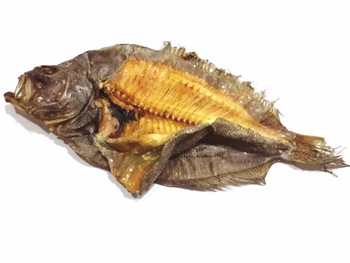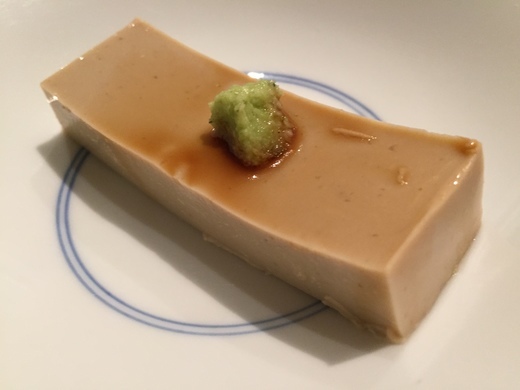And some yellow chives. ![]()
If it were me, I would hoard the dried shrimp roe and only use it sparingly on lo mein. If you’re feeling like a baller, you can also sprinkle it on steamed tofu.
Don’t know if you can get dried tilefish and fire roast it yourself, but if so perhaps try shaving that into powder then use that instead (ie putting it into the wonton filling), and that can also be shaved on top of lo mein, but if it gets too crunchy and dry some beef brisket or braised pork knuckle gravy would help moisten it a little (along with a splash of broth).
Darn all this talk of wonton, and I might might have to hit the HK cafe or jack of all trades Canto bistro for my half assed fix tomorrow!
tilefish or filefish? You can find korean filefish but otherwise can’t really find quality fish powder here. An alternative may be to use bonito powder but its not the same.
OK I screwed up and had to research it.
I think of filefish more like kawahagi that you see in high end sushi omakase (superb for the liver during winter). Tilefish is more like amadai… again, my bad.
It doesn’t help that in Hong Kong they use a generic name…the kind they use in HK is Pleuronectiformes, which is more or less “flatfish” (or dried flatfish for that matter). It is not tilefish or filefish (I have no idea how I heard it was tilefish before and can’t remember from where). The closest and more commonly used one is the local halibut, but dried flatfish as a category could also include flounder and sole families in addition, so I wouldn’t be surprised if you go to a dried seafood shop in HK and ask for dried flatfish for cooking that whatever is in their seasonal inventory could be more than one species or a mix. I guess in HK, any species of fish with googly eyes, flat and can bury itself to hide amongst the stones and sand on the ocean floor can be used as “dried flatfish”… sort of like the hirame, karei, makogarei, hoshigarei’s at the sushi bar (but it would be overkill to use those to do DIY dried flatfish for wonton noodle broth, lol)
Dried flounder / 大地魚 is what they use. Meat is taken out, fried, and grounded or blended into powder. This MSG can then be used in both stock and wonton.

Throwback to the time when I took a whole unopened jar of Kani Miso I brought from Takashimaya Osaka to Mori Sushi and asked Maru san to make something with it, and he helped himself to the whole jar and made a whole new batch of his signature tofu with it, and used some on a grilled bamboo app. I only got a taste of the new version of the tofu…those lucky customers that came in afterwards got the rest!



For anyone who’s interested in how the chef at a quite famous restaurant in Hong Kong, Spring Moon, make a home version of their signature char siu:
At Spring Moon, an order of char siu, which uses Hungarian Mangalica pork and roasted with either lychee or applewood, goes for about $35 USD.
Ingredients:
Pork Butt - 600g
Marinate:
Chinese Ground Bean Sauce - 25g
Red Fermented Bean Curd - 20g
Hoisin Sauce - 10g
Sesame Paste - 5g
Chinese Rose Wine - 35ml
Salt - 20g
Sugar - 500g (Very important for tenderizing)
Beet Juice - 20g
Maltose or Honey - To Taste
- Cut pork butt into 3 strips. It should be about 1cm thick, 4cm in width, 15cm in length.
- Put pork butt into ice water and chill in refrigerator for 4 hours before changing into a new batch of ice water and again chill in refrigerator for another 2 hours. (This is done to draw out as much blood as possible which is a common technique in Chinese cooking.)
- Take out pork butt and dry with paper towel.
- Combine all ingredients under marinate section into a paste and cover pork butt in marinate. Let sit for 20 mins in room temp.
- Preheat Oven to 320F and bake pork butt for 18 mins.
- Take out pork butt and brush a thin layer of maltose or honey on one side. Bake for 5 mins.
- Take out pork butt. Flip it over and again brush a thin layer of maltose or honey. Bake for 5 mins.
- QED
Oh man! No fair you got so little of that tofu!
Can I just say @TheCookie (love the toaster!) and @moonboy403 (no toaster compliment for you bro lol) did some beautiful work finishing the charsiu at home. Visually looks very successful, I totally would have triggered that charsiu to a burnt crisp and had charsiu bacon. I’m gonna need a single portion (like 1/3rd of the take-home package) charsiufan with the fried egg and some veggies, I’ll pay $18-20 for that if I don’t have to cook it lol
thanks for this…i have a lychee tree! but don’t see where he’s imparting that smoke in the video. looks like collar end of the pork butt.
He didn’t in the video since that’s a “home edition” that he came up for the masses. Hardly anybody in Hong Kong has a tree or even a backyard anyway. ![]()
Perhaps cold smoking would be a pretty quick and easy way to impart some of that smoky flavor in.
cold smoking is usually never quick esp if you want to impart that subtle smoke flavor with all that seasoning, plus it’s not cured, so slight safety issue,.but think hot smoking would work great too or just roast over wood lol .
we always use some sort of seafood umami booster–most vietnamese recipes for mi hoanh thanh broth uses charred dried squid or sa sung peanut worm, but in a pinch the shrimp shells or dried scallops or even kombu would work.
I was thinking of smoking gun that infuses just a tiny bit of smoke into the char siu since char siu aren’t very smoky traditionally. But then I’ve never worked with one before so I’ll defer to experts like you!
My mom cooked to a different standard. Lol
My mom tried making it a few times herself then said eff it. I’ve got better things to do with my time, here’s some money and the car keys, go get us a couple of pounds at Sam Woo. Teenage me goes YASSSS!!! I get to drive somewhere by myself!!!
Sam Woo Alhambra on Valley between Atlantic and Garfield!
when i first moved to LA 30 years (my god has it really been that long) one of my favorite pastimes was reading a cantonese menu is looking for misspelled words, although it wasn’t a misspelling as much as a transliteration of how the word was pronounced by immigrant cantonese speakers. memorable examples included:
roast pok
sea cucumba
garoupa
the tradition holds, though in this case, they spelled “a la carte” correctly the second time…
I found this vid awhile back, it’s 20 min and in cantonese, they talk about flatfish in the filling at 4:45, then in the soup at 16 min.
Not all places use 大地魚 (translated into flatfish) or “dai dei yu” in the soup or filling, but when they do, the flavor is intense. Sam woo on las tunas / 168 plaza was doing it awhile back, the soup had intense fishiness (in a good way). Recent trips unfortunately did not have the same strong flavor, which is a bit disappointing, it’s a distinct flavor.


